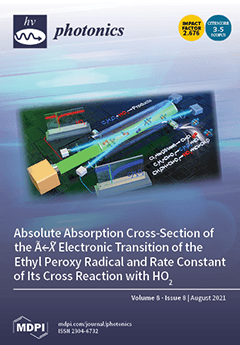A series of glass samples of the tungsten–tellurite system TeO
2-WO
3-Bi
2O
3-(4-x) La
2O
3-xEr
2O
3, x = 0; 0.4; 0.5; 0.7; 1.2; 2; 4 mol%, C
Er = 0 - 15
[...] Read more.
A series of glass samples of the tungsten–tellurite system TeO
2-WO
3-Bi
2O
3-(4-x) La
2O
3-xEr
2O
3, x = 0; 0.4; 0.5; 0.7; 1.2; 2; 4 mol%, C
Er = 0 - 15 × 10
20 cm
−3 were synthesized from high-purity oxides in an oxygen flow inside a specialized sealed reactor. In all samples of the series, an extremely low content of hydroxyl groups was achieved (~n × 10
16 cm
−3, more than 4 orders of magnitude lower than the concentration of erbium ions), which guarantees minimal effects on the luminescence properties of Er
3+. The glasses are resistant to crystallization up to 4 mol% Er
2O
3, and the glass transition temperatures do not depend on the concentration of erbium oxide when introduced by replacing lanthanum oxide. Thin 0.2 mm plates have high transmittance at a level of 20% in the 4.7–5.3 µm range, and the absorption bands of hydroxyl groups at about 2.3, 3, and 4.4 µm, which are typical for ordinary tellurite glass samples, are indistinguishable. The introduction of erbium oxide led to an insignificant change in the refractive index. Er
2O
3-concentration dependences of the luminescence intensities and lifetimes near the wavelengths of 1.53 and 2.75 μm were found for the
4I
13/2–
4I
15/2 and
4I
11/2–
4I
13/2 /transitions of the Er
3+ ion. The data obtained are necessary for the development of mid-infrared photonics; in particular, for the design of Er
3+-doped fiber lasers.
Full article





